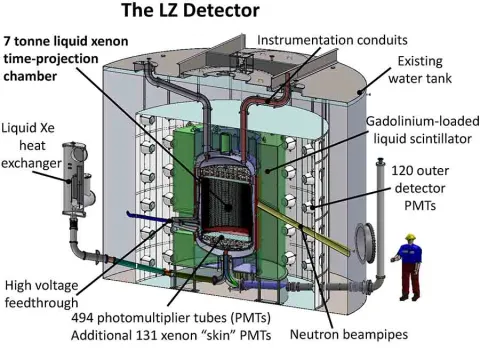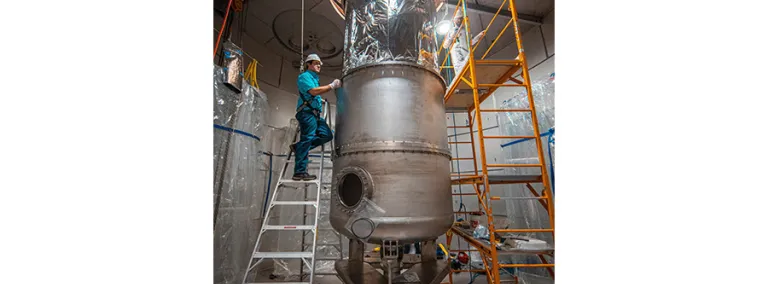LZ leads the race to directly detect dark matter
LUX-ZEPLIN (LZ) is a next-generation dark matter experiment located underground in the Black Hills of South Dakota.
The Sanford Underground Research Facility will celebrate Dark Matter Day on Thursday, Oct. 26, starting with a social hour at 5 p.m. (Mountain Time) and a panel discussion at 6 p.m. at the Sanford Lab Homestake Visitor Center in Lead, SD.
In the global race to directly detect dark matter, a project in South Dakota has lapped the field. LUX-ZEPLIN (LZ), next-generation dark matter experiment funded by the United States Department of Energy (DOE) Office of Science, is located nearly a mile below the surface at the Sanford Underground Research Facility (SURF) in Lead, South Dakota. This summer, results published from the first 60 days of the search put LZ in the pole position against other experiments in Canada, Korea, China, Europe, and elsewhere around the globe.
“The analogy I like to use is, we've been constructing this race car, it's built, it's ready. So, we take it around the block for an initial spin—and we break the land speed record,” said Dr. Chamkaur Ghag, the spokesperson for LZ and a professor of physics at University College London. “So we are, for the first time, in completely clear, uncharted discovery territory. We’re at the forefront of this race."
Scientists believe dark matter makes up most of the mass in the universe, but it’s invisible in everyday life—so how to do you see something that is essentially invisible? In the simplest sense, LZ is a thermos that contains slightly more than ten metric tons of liquid xenon at the core. Researchers believe some of the particles of dark matter streaming through every square inch of the universe will interact with some of the xenon atoms. You can think of this interaction as two pool balls colliding. When this reaction happens, it will cause a tiny flash of light to occur at the center of the xenon chamber, possibly indicating dark matter.
But seeing a dark matter interaction is a little like trying to hear a pin drop at a massive rock concert. The only way to pick out the minuscule noise of the pin hitting the floor—amidst the waves of blaring guitar solos—is to filter out all the other sounds happening around the pin. LZ is located deep underground to help filter out the cosmic rays that constantly bombard the planet and make it difficult to detect rare dark matter interactions.
Many people have heard of the Large Hadron Collider (LHC) at CERN. It’s the biggest particle accelerator on the planet and it examines the near light speed collisions of subatomic particles. “LHC does loud physics, what we are looking at in LZ is the quiet side of physics,” said Ghag. We are looking for low energy particles that almost never interact with matter.” But seeing these rare particle interactions is not easy.
Engineering a particle physics experiment is not for the faint of heart
In the field of physics, theorists explore the mathematical language we use to understand our universe. Based on the math, they put forward ideas, or theories. Dark matter is just one example. Experimentalists take ideas from theorists and design tests, or experiments, needed for validation. Over time, particle physics experiments have grown more complex and today, it’s up to engineers to build these large experiments.
Charles Maupin, one of the engineers who built LZ, will tell you engineering a major science experiment, nearly a mile underground, is in a class of its own. The challenges of a normal building project are compounded with the unique constraints of working 4,850 feet below the surface on highly sensitive equipment with zero tolerance levels for errors and a requirement to get it right the first time, every time.
“It’s like building a ship in a bottle, but the bottle neck is a mile long and you have to keep everything ultra clean and radiologically as pure as possible, Maupin said.

In every project of this complexity, unexpected events require occasional creative problem solving. Maupin and other engineers working on LZ had to occasionally find solutions on the fly. "You would have one fitting type here and one fitting type there, and we got very good at what we jokingly called ‘adapterizing,’ this is when you had to figure out what we could do with what we had on hand or what we could acquire on deadline that would work.”
That hard work paid off. LZ is up and running and taking data. For Maupin and other engineers at SURF there is a sense of satisfaction in the effort. “I will say for the group on site, it is a source of pride. We’re all from small communities around this region and we have been able to contribute to this world-class research right here at SURF,” Maupin said.
In total, the LZ collaboration consists of about 190 scientists from 36 institutions in the U.S., U.K., Portugal, and Korea. If LZ is successful at directly detecting dark matter, it would be groundbreaking in the world of physics, opening doors to new theories, new questions, and new innovation.
Is dark matter the next Copernican revolution?
Science has humbled us over time.
Copernicus, the 16th century mathematician and astronomer, was among the first to shatter the idea at the time that the sun revolves around the earth. He led the western realization that we humans might not be so important in the bigger scheme of things.
Today we know that we inhabit what Carl Sagan called a “pale blue dot,” that sits in a small part of a vast solar system, in an insignificant part of a mind-blowingly large galaxy, that is all but meaningless to the rest of the unimaginably large universe.
Dark matter might be the next bit of science that reduces our hubris.
“It's like another Copernican revolution,” said Dr. Flip Tanedo, an associate professor of theoretical physics at the University of California, Riverside. “Not only are we not located in any particularly special part of the universe, but the very things that we are made of, the chemistry of our entire universe, as we understood it pre-1900s, is not even the most predominant stuff of the universe.” Tanedo’s research seeks to discover how dark matter fits into our fundamental understanding of nature.
Tanedo is excited by the experimental precision that has been reached by LZ. “This is a level of sensitivity, that I don't think we ever could have imagined 20 years ago,” he said. The fact that LZ has yet to report a dark matter signal is also telling. “LZ has, unfortunately, not yet discovered dark matter. What that really means is that the things we were expecting 20 years ago, seemed to have not panned out. And something much more exciting must be happening. It's throwing down the gauntlet for theorists to be more creative.”
But the race isn’t over.
If dark matter is in fact a particle that can be detected “then we've known for a long time that we need an experiment something like the size of LZ,” Ghag said. The fact that LZ is now operating, and planning is underway for the next generation beyond it, opens many doors for scientists to explore.
“This is a playground where you can test theories and models for new physics,” he added. “But just the fact that we are here, all the technological work; the decades of experiments, research, and development; the massive holes in the ground; the infrastructure and all the people supporting it—it's kind of incredible that all of this has come together to allow us to seek answers to these questions about our universe.”
LZ is led by Lawrence Berkeley National Laboratory, and is supported by the U.S. Department of Energy, Office of Science, Office of High Energy Physics and the National Energy Research Scientific Computing Center, a DOE Office of Science user facility. LZ is also supported by the Science & Technology Facilities Council of the United Kingdom; the Portuguese Foundation for Science and Technology; and the Institute for Basic Science, Korea.
The Sanford Underground Research Facility will celebrate Dark Matter Day on Thursday, Oct. 26, starting with a social hour at 5 p.m. (Mountain Time) and a panel discussion at 6 p.m. at the Sanford Lab Homestake Visitor Center in Lead, SD.
